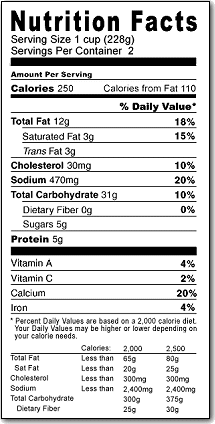当前你的浏览器版本过低,网站已在兼容模式下运行,兼容模式仅提供最小功能支持,网站样式可能显示不正常。
请尽快升级浏览器以体验网站在线编辑、在线运行等功能。
2959:Close Enough Computations
题目描述
The nutritional food label has become ubiquitous. A sample label is shown to the right. On the label the number of calories and the number of grams of fat, carbohydrate, and protein are given as integers.

But carefully reading the label may cause the consumer to notice some inconsistencies. A gram of fat has 9 calories, a gram of carbohydrate has 4 calories, and a gram of protein has 4 calories. Consider the label to the right. A simple computation of the number of calories would indicate that the food should contain 12*9 + 31*4 + 5*4 or 252 calories, but the label indicates it has 250 calories.
While sometimes the difference in calories is due to other circumstances (such as the presence of alcohol or soluble fiber), this problem will consider only the possibility of round-off error. This food actually has 12.1 grams of fat (yielding 108.9 calories), 30.6 grams of carbohydrate (122.4 calories), 4.7 grams of protein (18.8 calories), so it does in fact have 250 calories (actually 250.1 calories).
Write a program that will determine if values for a nutritional label are consistent, that is, if there is a way the true values for the grams of nutrients can be rounded to the shown values and yield the number of calories shown.
You should assume that standard rounding rules apply; that is any value less than 0.5 rounds down and those 0.5 or over round up.

But carefully reading the label may cause the consumer to notice some inconsistencies. A gram of fat has 9 calories, a gram of carbohydrate has 4 calories, and a gram of protein has 4 calories. Consider the label to the right. A simple computation of the number of calories would indicate that the food should contain 12*9 + 31*4 + 5*4 or 252 calories, but the label indicates it has 250 calories.
While sometimes the difference in calories is due to other circumstances (such as the presence of alcohol or soluble fiber), this problem will consider only the possibility of round-off error. This food actually has 12.1 grams of fat (yielding 108.9 calories), 30.6 grams of carbohydrate (122.4 calories), 4.7 grams of protein (18.8 calories), so it does in fact have 250 calories (actually 250.1 calories).
Write a program that will determine if values for a nutritional label are consistent, that is, if there is a way the true values for the grams of nutrients can be rounded to the shown values and yield the number of calories shown.
You should assume that standard rounding rules apply; that is any value less than 0.5 rounds down and those 0.5 or over round up.
输入解释
The input will contain one or more sets of data about potential labels. Each data set will consist of 4 non-negative integers, separated by one or more blanks, on a single line. The integers represent the number of calories, the number of grams of fat, the number of grams of carbohydrates, and the number of grams of protein, in that order. The number of calories will not exceed 10000, and the number of grams of any component will not exceed 1000.
End of input is indicated by a line containing 4 zeroes. This line should not be processed.
End of input is indicated by a line containing 4 zeroes. This line should not be processed.
输出解释
For each data set, print "yes" or "no" on its own line, indicating whether the given rounded values of the three nutrients can yield the given number of calories.
输入样例
250 12 31 5 250 13 31 5 122 10 10 0 0 0 0 0
输出样例
yes no no
来自杭电HDUOJ的附加信息
| Recommend | gaojie |
最后修改于 2020-10-25T22:58:40+00:00 由爬虫自动更新
共提交 0 次
通过率 --%
| 时间上限 | 内存上限 |
| 2000/1000MS(Java/Others) | 32768/32768K(Java/Others) |
登陆或注册以提交代码